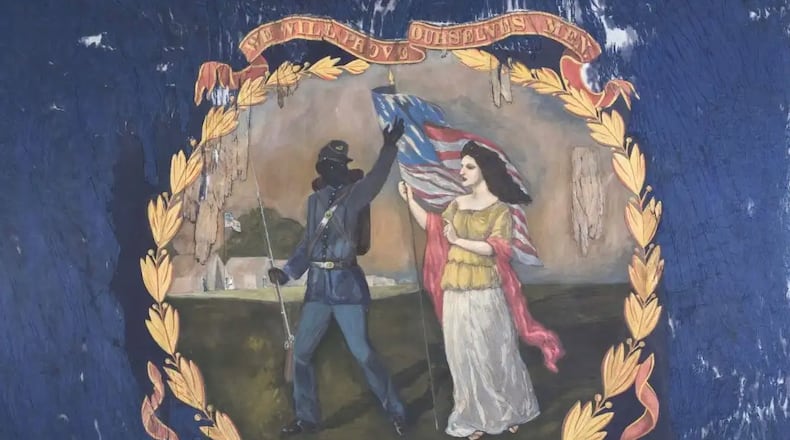“We Will Prove Ourselves Men,” reads the inscription at the top of the regimental flag carried into battle by members of the 127th United States Colored Troops.
The phrase offers a sense of what was at stake for black men, many of whom formerly in bondage, who fought to end slavery during the Civil War. Dehumanized by their enslavers, classified as household property, they vowed to demonstrate their worth in a fight for their lives.
Six feet wide and more than four feet tall, the silk flag was painted by an African American artist in Philadelphia. It is now in the collection of the Atlanta History Center, and, at almost $200,000, it represents the most expensive artifact the center has acquired.
It shows a black soldier carrying a rifle and bidding goodbye to a white figure dressed as “Columbia,” representing the U.S.
The center announced its acquisition Friday, June 14.
According to the history center, at least 180,000 African Americans served in the United States Colored Troops, a branch of the U.S. Army formed after the Emancipation Proclamation of 1863.
The units were segregated, and commanded by white officers. Estimates are that three-fourths of the soldiers were formerly enslaved men.
The history center has 11,000 items in its Civil War collection, which is one of the largest in the nation, and includes the Beverly M. DuBose Family Collection and the George W. Wray Collection.
Items from those collections are displayed in the 9,200-square-foot exhibit "Turning Point: The American Civil War." In February the center opened an exhibit centered around the enormous "Battle of Atlanta" cyclorama painting.
But items specifically associated with the U.S. Colored Troops are very rare, and the center owns only a dozen.
This is partly because black soldiers were issued the same uniforms and equipment as white soldiers. “So unless a soldier put his name on a piece of gear or it came down through the family, we will never know who used it,” said Gordon Jones, military historian and curator at the history center.
Exceptions are battle flags of USCT regiments. There are perhaps 25 such flags in existence. Jones said he had been on the lookout for such a flag to come to auction.
This is the only surviving example of 11 similar flags painted by David Bustill Bowser, a Philadelphia sign-painter, portraitist and anti-slavery activist.
The flag had previously been displayed at the Grand Army of the Republic Civil War Museum and Library in Philadelphia.
Silk is a particularly fragile material, said Jones, and much of the flag had deteriorated. He said fragments of the original painting had been reassembled, “like pieces of a puzzle,” during extensive restoration of the artifact.
As of Friday, it still had not been shipped to Atlanta.
The auction took place in Denver, Pa., 60 miles west of Philadelphia. A small group of bidders physically attended the auction, while many others, including Jones, participated online.
The auction price was $160,000, plus a $36,800 buyer’s premium. It’s the highest price paid for an artifact by the history center, which has received most of its objects through donations.
The 127th served during the U.S. siege of Petersburg, Virginia and was present during the the surrender at Appomattox Courthouse. Afterwards the regiment participated in occupation duty in Texas.
“This flag is worth it in exhibit value alone,” said Atlanta History Center president and CEO Sheffield Hale, in a statement. “It’s one of those things that doesn’t need words to tell you what it is and what it represents.”
Jones said “Very few artifacts have that kind of emotional punch.”
About the Author
Keep Reading
The Latest
Featured




